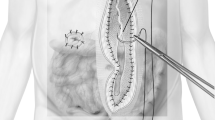Abstract
Purpose
The aim of this study was to analyze the management of enteroatmospheric fistulae (EAF) in an open abdomen using vacuum-assisted closure (VAC) therapy.
Methods
Eighteen patients (ten male/eight female) were treated in our surgical department for the management of EAF. VAC therapy was used to manage both complex and open abdominal wounds and for effluent control in all patients except one until definitive surgery could be performed or spontaneous closure of the EAF occurred.
Results
The median age of the patients was 61.1 years (range 29–84 years). Their average hospital stay was 88.89 days (range 22–129 days). The median number of VAC applications was 22.5, and the median duration of VAC applications was 43.6 days (range 14–114 days). Non-surgical spontaneous closure of the fistulae with negative pressure wound therapy could be achieved in four patients. In the other six patients, after the EAF were controlled with VAC therapy, definitive surgery was performed. Primary fascial repair was performed in two patients, and the component separation technique was synchronously performed in another two patients. Ventral hernia repair using polypropylene mesh was performed in a patient 1 year after discharge from the hospital. One patient was discharged with skin grafting plus ileostomy after the EAF was managed with VAC therapy. Eight patients (44.4 %) died due to intraabdominal infections and sepsis, which could not be controlled despite all precautions. No VAC-related complications were observed in this study.
Conclusion
A VAC system can be successfully used for wound management in the control of fistula effluent in patients with an EAF in an open abdomen until spontaneous fistula closure occurs or definitive fistula surgery can be performed.


Similar content being viewed by others
References
Marinis A, Gkiokas G, Argyra E, Fragulidis G, Polymeneas G, Voros D. “Enteroatmospheric fistulae”—gastrointestinal openings in the open abdomen: a review and recent proposal of a surgical technique. Scand J Surg. 2013;102:61–8.
Verhaalen A, Walkins B, Brasel K. Technique sand cost effectiveness of enteroatmospheric fistula isolation. Wounds. 2010;22:212–7.
D’Hondt M, Devriendt D, Van Rooy F, Vansteenkiste F, D’Hoore A, Penninckx F, et al. Treatment of small-bowel fistulae in the open abdomen with topical negative-pressure therapy. Am J Surg. 2011;202:20–4.
Evenson RA, Fischer JE. Treatment of enteric fistulae in the open abdomen. Chirurg. 2006;77:594–601.
Ramsay PT, Mejia VA. Management of enteroatmospheric fistulae in the open abdomen. Am Surg. 2010;76:637–9.
Layton B, Dubose J, Nichols S, Connaughton J, Jones T, Pratt J. Pacifying the open abdomen with concomitant intestinal fistula: a novel approach. Am J Surg. 2010;199:48–50.
Becker HP, Willms A, Schwab R. Small bowel fistulas and the open abdomen. Scand J Surg. 2007;96:263–71.
Schecter WP. Management of enterocutaneous fistulas. Surg Clin North Am. 2011;91:481–91.
Marinis A, Gkiokas G, Anastasopoulos G, Fragulidis G, Theodosopoulos T, Kotsis T, et al. Surgical techniques for the management of enteroatmospheric fistulae. Surg Infect. 2009;10:47–52.
Cipolla J, Baillie DR, Steinberg SM, Martin ND, Jaik NP, Lukaszczyk JJ, et al. Negative pressure wound therapy: unusual and innovative applications. OPUS 12 Sci. 2008;2:15–28.
Kearney R, Payne W, Rosemurgy A. Extra-abdominal closure of enterocutaneous fistula. Am Surg. 1997;63:406–9.
Schrag SP, Sharma R, Jaik NP, Seamon MJ, Lukaszczyk JJ, Martin ND, et al. Complications related to percutaneous endoscopic gastrostomy (PEG) tubes. A comprehensive clinical review. J Gastrointest Liver Dis. 2007;16:407–18.
Girard S, Sideman M, Spain D. A novel approach to the problem of intestinal fistulization arising in patients managed with open peritoneal cavities. Am J Surg. 2002;184:166–7.
Subramaniam MH, Liscum KR, Hirshberg A. The floating stoma: a new technique for controlling exposed fistulae in abdominal trauma. J Trauma. 2002;53:386–8.
Goverman J, Yelon JA, Platz JJ, Singson RC, Turcinovic M. The, “Fistula VAC”, a technique for management of enterocutaneous fistulae arising within the open abdomen: report of 5 cases. J Trauma. 2006;60:428–31.
Kubiak BD, Albert SP, Gatto LA, Snyder KP, Maier KG, Vieau CJ, et al. Peritoneal negative pressure therapy prevents multiple organ injury in a chronic porcine sepsis and ischemia/reperfusion model. Shock. 2010;34:525–34.
Jacobs S, Simhaee DA, Marsano A, Fomovsky GM, Niedt G, Wu JK. Efficacy and mechanisms of vacuum-assisted closure (VAC) therapy in promoting wound healing: a rodent model. J Plast Reconstr Aesthet Surg. 2009;62:1331–8.
Cheatham ML, Demetriades D, Fabian TC, Kaplan MJ, Miles WS, Schreiber MA, et al. Prospective study examining clinical outcomes associated with a negative pressure wound therapy system and Barker’s vacuum packing technique. World J Surg. 2013;37:2018–30.
DiSaverio S, Villani S, Biscardi A, Giorgini E, Tugnoli G. Open abdomen with concomitant enteroatmospheric fistula: validation, refinements, and adjuncts to a novel approach. J Trauma. 2011;71:760–2.
Aguila DJ, Hui-Chou HG, Lifchez SD. The stool shield: a novel approach to the colo-atmospheric fistula. J Am Coll Surg. 2011;213:17–20.
Pang TC, Morton J, Pincott S. Novel technique for isolating and dressing enteroatmospheric fistulae. ANZ J Surg. 2012;82:747–9.
González-Pinto I, González EM. Optimising the treatment of upper gastrointestinal fistulae. Gut. 2001;49:22–31.
Pretorius JP, Liebenberg C, Piek D, Smith M. The open abdomen part 3: management of the grade 3 open abdomen with entero-atmospheric fistulae. Wound Heal South Afr. 2011;4:94–102.
Llyod DA, Gabe SM, Windsor AC. Nutrition and management of enterocutaneous fistula. Br J Surg. 2006;93:1045–55.
Demetriades D. Total management of the open abdomen. Int Wound J. 2012;9:17–24.
Conflict of interest
The authors declare that they have no conflicts of interest.
Author information
Authors and Affiliations
Corresponding author
Rights and permissions
About this article
Cite this article
Tavusbay, C., Genc, H., Cin, N. et al. Use of a vacuum-assisted closure system for the management of enteroatmospheric fistulae. Surg Today 45, 1102–1111 (2015). https://doi.org/10.1007/s00595-014-1020-3
Received:
Accepted:
Published:
Issue Date:
DOI: https://doi.org/10.1007/s00595-014-1020-3




